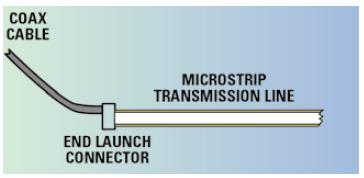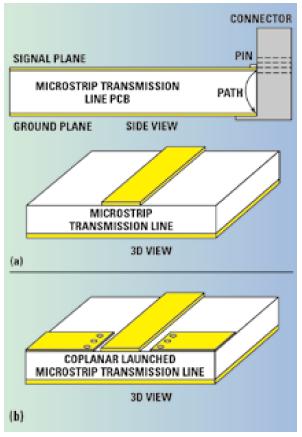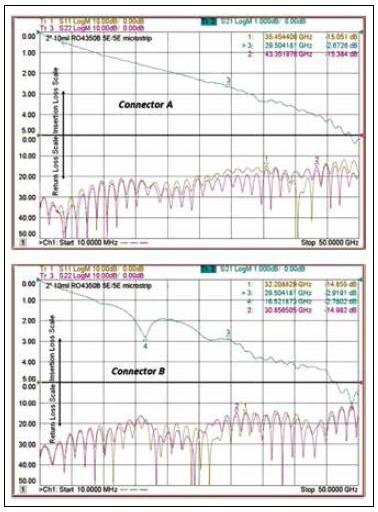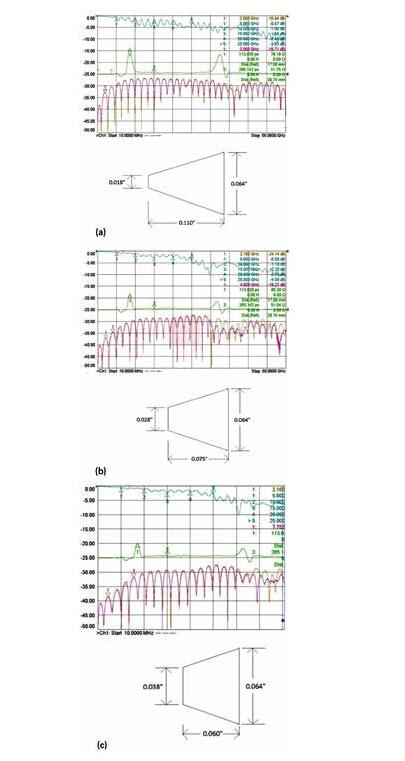The process of transferring High-Frequency Energy and RF/Microwave PCB from a coaxial connector to a printed circuit board (PCB) is often referred to as signal injection, and its characteristics are difficult to describe. The efficiency of energy transfer varies greatly depending on the circuit structure. Factors such as the PCB material and its thickness and operating frequency range, as well as the connector design and its interaction with the circuit material, can affect performance. Performance can be improved by an understanding of different signal injection Settings and a review of some optimization cases of RF and microwave signal injection methods.
Achieving effective signal injection is design-related, and generally, broadband optimization is more challenging than narrowband optimization. In general, high-frequency injection becomes more difficult as the frequency increases and may become more problematic as the thickness of the circuit material increases and the complexity of the circuit structure increases.
Signal injection design and optimization
Signal injection from the coaxial cable and connector into the microstrip PCB is shown in Figure 1. The electromagnetic (EM) field distribution through coaxial cables and connectors is cylindrical, while the EM field distribution within a PCB is planar or rectangular. From one medium to another, the field distribution changes to adapt to the new environment, resulting in anomalies. The change depends on the type of medium; For example, signal injection is from coaxial cables and connectors to microstrip, ground coplanar waveguide (GCP), or strip. The type of coaxial cable connector also plays an important role.

Figure 1. Signal injection from coaxial cable and connector to microstrip
Optimization involves several variables. Understanding the EM field distribution within a coaxial cable/connector is useful, but the ground loop must also be considered part of the propagation medium. It is usually helpful to achieve a smooth impedance transition from one propagation medium to another. Understanding the capacitance and inductive reactance at the impedance discontinuities allows us to understand circuit performance. If a 3D (3D) EM simulation can be performed, the current density distribution can be observed. In addition, it is desirable to take into account the practical conditions relating to radiation losses.
While the ground loop between the signal transmitter connector and PCB may seem unproblematic, the ground loop from the connector to the PCB is very continuous, but this is not always the case. There is usually a small surface resistance between the metal of the connector and the PCB. There are also small differences in electrical conductivity between the welders that connect different parts and the metals in those parts. At low RF and microwave frequencies, these small differences usually have a small impact, but at higher frequencies, they can have a significant impact on performance. The actual length of the backflow path affects the quality of transmission that can be achieved with a given combination of connectors and PCBs.
As shown in Figure 2A, the ground loop back to the connector housing may be too long for thick microstrip transmission lines as electromagnetic energy is transferred from the connector pins to the signal lead of the microstrip PCB. Using PCB materials with high frequency dielectric constants can exacerbate the problem by increasing the electrical length of the ground loop. The path extension can cause frequency-dependent problems, resulting in local phase velocity and capacitance differences. Both of them are related to the impedance in the transformation region and will affect it, resulting in return loss differences. Ideally, the length of the ground loop should be minimized so that there is no impedance anomaly in the signal injection area. Note that the ground point of the connector shown in Figure 2A exists only at the bottom of the circuit, and this is the worst case. Many RF connectors have ground pins on the same layer as the signal. In this case, the PCB will also be designed with a grounding pad there.
Figure 2B shows a ground coplanar waveguide to microstrip signal injection circuit. Here, the main body of the circuit is the microstrip, but the signal injection region is the ground coplanar waveguide (GCP). Coplanar emission microstrips are useful because they minimize ground loops and have other useful properties. If a connector is used with ground pins on both sides of the signal lead, ground pin spacing has a significant impact on performance. It has been shown that distance affects the frequency response.

Figure 2. Thick microstrip transmission line circuit and longer ground return path to connector (a)
Ground coplanar waveguide to microstrip signal injection circuit (b)
In experiments with a coplanar waveguide to microstrip based on Rogers 10mIL thick RO4350B laminates, coplanar waveguide ports with different ground spacing but otherwise similar connectors were used (see Figure 3). Connector A has A grounding interval of approximately 0.030" and connector B has A grounding interval of 0.064". In both cases, the connector is emitted on the same circuit.

Figure 3. Test coplanar waveguide to microstrip circuits using coaxial connectors with similar ports with different grounding intervals
The X-axis is the frequency, 5 GHz per grid. At low microwave frequencies (< 5 GHz), the performance of the circuit is the same, but at frequencies higher than 15 GHz, the performance of the circuit with a large grounding interval deteriorates. The connectors are similar, although the pin diameters of the two models are slightly different, connector B has a larger pin diameter and is designed for thicker PCB materials. This can also lead to performance differences.
A simple and effective method for optimizing signal injection is to minimize the impedance mismatch in the signal transmitting region. The impedance curve rises basically because of an increase in inductance and falls because of an increase in capacitance. For the thick microstrip transmission line shown in Figure 2A (assuming a low dielectric constant of the PCB material, about 3.6), the conductor is wider - much wider than the inner conductor of the connector. Because of the large size difference between the circuit lead and the connector lead, there is a strong capacitive mutation during the transition. Capacitive mutations can usually be reduced by tapering the circuit lead so as to reduce the size gap between it and the coaxial connector pins. Narrowing the PCB lead will increase its sensitivity (or decrease capacitive, thereby offsetting capacitive mutations in the impedance curve.
The effect on different frequencies must be considered. Longer gradients give more sensitivity to low frequencies. For example, if the return loss is poor at low frequencies and there is a capacitive impedance spike, a longer gradient line may be appropriate. Conversely, shorter gradients have a greater effect on high frequencies.
For coplanar structures, capacitance increases when adjacent ground surfaces approach. Generally, the sensitivity of the signal injection region is adjusted in the corresponding frequency band by adjusting the spacing between the gradient signal line and the adjacent ground. In some cases, the adjacent grounding pads of the coplanar waveguide are wider along one section of the gradient line to regulate the lower frequency band. Then, the spacing Narrows at the wider part of the gradient line, and the narrower part is not long in length to affect the high-frequency band. In general, the narrowing of the wire gradient increases the sensation. The length of the gradient line affects the frequency response. The capacitance can be changed by changing the adjacent grounding pads of coplanar waveguides. The spacing between pads can change the frequency response, which plays a major role in the change of capacitive.
The instance
Figure 4 provides a simple example. Figure 4A is a thick microstrip transmission line with a long and narrow gradient. The gradient line is 0.018" (0.46 mm) wide and 0.110" (2.794 mm) long at the edge of the plate, and finally becomes a 50 ω line width of 0.064" (1.626 mm) wide. In Figures 4b and 4c, the length of the gradient line becomes shorter. Field crimp terminal connectors are used and not welded, so the same inner conductor is used in each case. The microstrip transmission line is 2" (50.8mm) long and machined in a 30mil (0.76mm) thick RO4350B? The dielectric constant of microwave circuit laminates is 3.66. In Figure 4A, the blue curve represents the insertion loss (S21), which fluctuates a lot. On the contrary, S21 in Figure 4c has the least amount of fluctuation. These curves show that the shorter the gradient, the better the performance.

Figure 4. Performance of three microstrip circuits with different gradient lines; Original design with narrow gradient (a), reduced gradient length (b), and further reduced gradient length (c)
Perhaps the most illustrative curve in Figure 4 shows the impedance of the cable, connector, and circuit (green curve). The large forward wave in Figure 4A represents the connector port 1 connected to the coaxial cable, and the other peak on the curve represents the connector at the other end of the circuit. The fluctuation in the impedance curve is reduced by the shortening of the gradient line. The improvement of impedance matching is due to the widening and narrowing of the gradient line in the signal injection region. The wider gradients reduce the sensuality.
We can learn more about the size of the injection area circuit from an excellent signal injection design 2, which also uses the same plate and the same thickness. A coplanar waveguide to the microstrip circuit board, using the experience in Figure 4, produces better results than in Figure 4. The most obvious improvement is the elimination of inductive peaks in the impedance curve, which in fact is partly due to inductive peaks and capacitive valleys. Using the correct gradient line is to minimize the sensitivity peak while using the injection zone coplanar grounding pad coupling to increase sensitivity. The insertion loss curve in FIG. 5 is smoother than that in FIG. 4C and the return loss curve are also improved. The example shown in Figure 4 shows different results for microstrip circuits using PCB materials with High-Frequency Energy and RF/Microwave PCB dielectric constants or different thicknesses, or for microstrip circuits using different types of connectors.